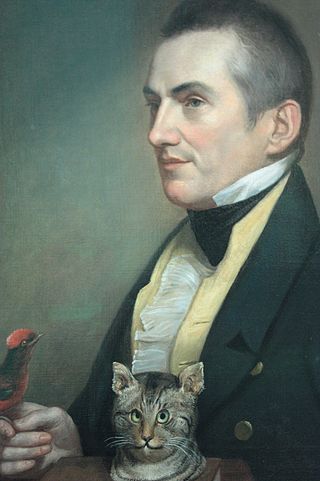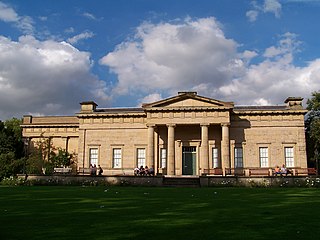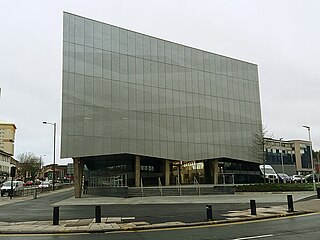

Wakefield Museum is a local museum in Wakefield, West Yorkshire, north England, covering the history of the city of Wakefield and the local area from prehistoric times onwards. [1]


Wakefield Museum is a local museum in Wakefield, West Yorkshire, north England, covering the history of the city of Wakefield and the local area from prehistoric times onwards. [1]
From 1955 Wakefield Museum was housed in the former Wakefield Mechanics' Institute, a 19th-century listed building. Wakefield Museum has been in its current home, the Wakefield One civic building, since 2013. The relocated museum was officially opened by Sir David Attenborough in March 2013. [2]
The museum covers the story of Wakefield, looking at the Manor of Wakefield in the Tudor period, HM Prison Wakefield, Wakefield as the West Yorkshire Police Headquarters, Wakefield Trinity Wildcats, The Battle of Wakefield, Wakefield's writers and theatres and more.
There is a dedicated area to Charles Waterton - a pioneering Victorian eco-warrior, explorer and Yorkshireman. Waterton developed a nature park (arguably the first in Europe) at his home, Walton Hall near Wakefield. [2] His collection of preserved animals some made up from different animal parts can be seen. The caiman which Waterton rode ashore in South America is displayed under the floor, allowing visitors to get a unique view of this special object. The collection belongs to Stonyhurst College which has loaned the collection to the museum since 1967. [3] The loan is planned to end at the end of 2022. [3]
Other exhibits include an 1809 post box believed to be the oldest example in Britain, a pair of boots which belonged to Rugby league player, Don Fox, and a medieval posy ring from Sandal Castle.

West Yorkshire is a metropolitan and ceremonial county in the Yorkshire and the Humber region of England. It borders North Yorkshire to the north and east, South Yorkshire and Derbyshire to the south, Greater Manchester to the south-west, and Lancashire to the west. The city of Leeds is the largest settlement.

Walton is a village and civil parish in the City of Wakefield in the county of West Yorkshire, England, 4 miles south-east of Wakefield. At the time of the 2011 Census, the parish had a population of 3,231. At the time of the 2011 Census the parish was part of the City of Wakefield's ward of Crofton, Ryhill and Walton. The population of this ward at the Census was 15,144.

Walton Hall is a country house in Walton near Wakefield in West Yorkshire, England. It was built on the site of a former moated medieval hall in the Palladian style in 1767 on an island in a 26-acre (11 ha) lake. It was the ancestral home of the naturalist and traveller Charles Waterton, who made Walton Hall into the world's first wildfowl and nature reserve. Waterton's son, Edmund, sold the estate.

Charles Waterton was an English naturalist, plantation overseer and explorer best known for his pioneering work regarding conservation.

Wakefield is a cathedral city in West Yorkshire, England located on the River Calder. The city had a population of 109,766 in the 2021 census, up from 99,251 in the 2011 census. The city is the administrative centre of the wider Metropolitan Borough of Wakefield, which had a 2021 population of 353,802, the 25th most populous district in England. It is part of the West Yorkshire Built-up Area and the Yorkshire and The Humber region.

Pontefract is a historic market town in the Metropolitan Borough of Wakefield in West Yorkshire, England, east of Wakefield and south of Castleford. Historically part of the West Riding of Yorkshire, it is one of the towns in the City of Wakefield district and had a population of 30,881 at the 2011 Census. Pontefract's motto is Post mortem patris pro filio, Latin for "After the death of the father, support the son", a reference to the town's Royalist sympathies in the English Civil War. Small villages and settlements in the immediate area include Stapleton.

Conisbrough is a town within the City of Doncaster, in South Yorkshire, England. It is roughly midway between Doncaster and Rotherham, and is built alongside the River Don at 53°29′N1°14′W. It has a ward population of 14,333.

PontefractCastle is a castle ruin in the town of Pontefract, in West Yorkshire, England. King Richard II is thought to have died there. It was the site of a series of famous sieges during the 17th-century English Civil War.

Wakefield, also known as the City of Wakefield, is a local government district with city status and a metropolitan borough in West Yorkshire, England. Wakefield, the largest settlement, is the administrative centre of the district. The population of the City of Wakefield at the 2011 Census was 325,837.

Cartwright Hall is the civic art gallery in Bradford, West Yorkshire, England, situated about a mile from the city centre in the Manningham district. It was built on the former site of Manningham Hall using a gift of £40,000 donated by Samuel Lister and it is named after Edmund Cartwright. The gallery which opened in 1904 initially had a display of artworks loaned from other galleries and private collections until it was able to purchase a permanent collection of Victorian and Edwardian works using money raised by the 1904 Bradford Exhibition.

The Leicester Museum & Art Gallery is a museum on New Walk in Leicester, England, not far from the city centre. It opened in 1849 as one of the first public museums in the United Kingdom. Leicester Museum & Art Gallery contains displays of science, history and art, both international and local. The original building was designed by Joseph Hansom, designer of the hansom cab. It has been expanded several times, most recently in 2011.

Pontefract Museum is a local museum in Pontefract, West Yorkshire, England. The collections cover archaeology, archives, decorative and applied art, fine art, photographs and social history.

Woolley Hall is a country house in Woolley, West Yorkshire, England. It is a Grade II* listed building.
Gilling Castle is a Grade I listed country house near Gilling East, North Yorkshire, England.

The Yorkshire Museum is a museum in York, England. It was opened in 1830, and has five permanent collections, covering biology, geology, archaeology, numismatics and astronomy.

The Jesuit origins of Stonyhurst College in Lancashire, England, have enabled it to amass a large collection of books, a number of which concern recusant history, whilst artefacts from all over the world have been donated to the school by Jesuit missionaries and alumni. The school has four main libraries: the Arundell, the Bay, the Square and the More. It also has two museums: the Do Room and the Long Room.

Ilkley Manor House, Ilkley, West Yorkshire, England, is a local heritage museum, art gallery, and live venue, and was established in the present building in 1961 to preserve local archaeological artefacts after the spa town expanded and much Roman material was lost. It was managed by Bradford Council Museums and Galleries department but had to be closed in 2013 owing to lack of funds. In order to keep the building open to the public, the Ilkley Manor House Trust was formed, and in April 2018, Bradford Council transferred the Manor House and three adjacent cottages to the Trust as a community asset transfer.

Cliffe Castle Museum, Keighley, West Yorkshire, England, is a local heritage museum which opened in the grand, Victorian, neo-Gothic Cliffe Castle in 1959. Originating as Cliffe Hall in 1828, the museum is the successor to Keighley Museum which opened in Eastwood House, Keighley, in c. 1892. There is a series of galleries dedicated to various aspects of local heritage, and to displaying the house itself, which is a Grade II listed building. Entrance to the museum is free of charge.

Fairfax House is a Georgian townhouse located at No. 27, Castlegate, York, England, near Clifford's Tower and York Castle Museum. It was probably built in the early 1740s for a local merchant and in 1759 it was purchased by Charles Gregory Fairfax, 9th Viscount Fairfax of Emley, who arranged for the interior to be remodelled by John Carr (architect). Fairfax was the widower of heiress Elizabeth Clifford, daughter of Hugh Clifford, 2nd Baron Clifford of Chudleigh: his inheritance from her death enabled him to purchase the house, which he intended as a home for his daughter from his first marriage, Ann Fairfax.

The West Yorkshire History Centre is an archive in Wakefield, in West Yorkshire, in England.